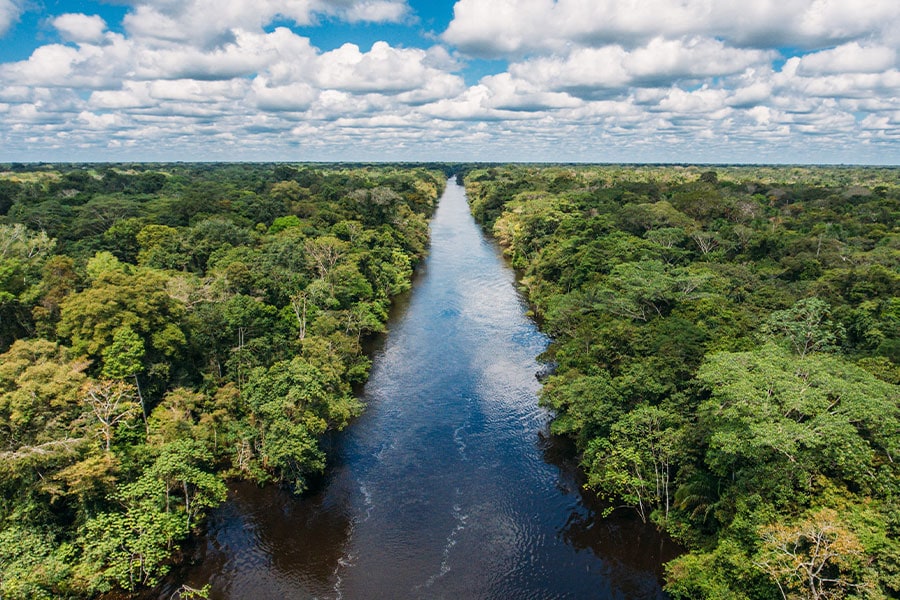Amazon Facts
Official Name:
Amazon basin / Amazon rainforest
Also Known As:
Amazonia / Amazon Jungle
Government:
54% of the Amazon basin is in Brazil, remainder in Peru and other countries. The Amazon rainforest covers the basin / parts of nine countries, 60% in Brazil, 13% in Peru, and smaller areas of Ecuador, Colombia, Venezuela, Bolivia, Guyana, Suriname and French Guiana.
Population:
Sparsely populated, scattered cities including Manaus & Belem (Brazil), Iquitos & Puerto Maldonado (Peru). The Amazon region contains over 300 indigenous tribes. About 70 tribes have yet to make formal contact with the outside world. Less than 200,000 indigenous people live in the rainforest.
Language:
Portuguese (Brazil), Spanish widely spoken elsewhere, many languages spoken by indigenous people.
Amazon River:
Second longest in the world – 6,400 kilometres from Andes to Atlantic Ocean.
Total Land Area:
5,500,000 square kilometres (2,123,562 square miles) in the Amazon basin.
About the Amazon
The Amazon is an area of tropical evergreen broadleaf rainforest covering half a billion square kilometres over 9 countries in the northern area of South America. The forest receives a high rainfall (more than 2,000 millimetres or 80 inches annually) throughout the year.
The life force of the Amazon rainforest is the Amazon River, which begins in the Andes Mountains at the west of the Amazon basin, and covers a distance of about 6,400 kilometres (4,000 miles) before draining into the Atlantic Ocean at Belem, Brazil.
The Amazon accounts for about 20% of the total water carried to the oceans by rivers and is fed by some 1,100 tributaries, 17 of which are thousands of kilometres long, with the entire network covering some 6 million square kilometres.
Why visit the Amazon Jungle?
A visit to the Amazon Jungle of Peru, Brazil or Ecuador with Tucan Travel offers the opportunity to breathe in some of the purest air on the planet and see some of the world’s most amazing birds and animals in their natural rainforest habitat. From bullet ants to tarantulas, jaguars to capybaras, piranhas to giant river otters, capuchins to howler monkeys and much more, this is an important destination not to be missed.
Amazon flora and fauna
The Amazon basin region is home to about 2.5 million insect species, tens of thousands of plants, and some 2,000 birds and mammals. To date, at least 40,000 plant species, 3,000 fish, 1,294 birds, 427 mammals, 428 amphibians, and 378 reptiles have been scientifically classified in the region. One in five of all the birds in the world live in the rainforests of the Amazon. Scientists have described between 96,660 and 128,843 invertebrate species in Brazil alone.
The diversity of plant species in the Amazon is the highest on Earth. Experts estimate that one square kilometre of Amazon rainforest can contain about 90,790 tonnes of living plants, comprised of 75,000 types of trees and 150,000 species of higher plants. An estimated 438,000 species of plants of economic and social interest have been registered in the region with many more remaining to be discovered or catalogued.
Why is the Amazon so important?
The Amazon rainforest has been described as the lungs of our planet because of its crucial role in recycling carbon dioxide into oxygen. About half the world’s tropical rainforests are in Brazil and Peru, in the Amazon region. Due to deforestation, rainforests now cover less than 5% of the Earth’s land surface, and experts believe that this is a big contributor to global climate change.
The biodiversity of the Amazon rainforest is of profound importance to the wellbeing of mankind and in fact, the planet. Apart from the fact that it is responsible for global ecological services such as water filtration and carbon sequestration (locking carbon into trees, recycling the oxygen into the atmosphere), the rainforest is also a giant pharmacy with tremendous unrealised potential for treating diseases. For example, more than 120 prescription drugs sold worldwide come from plant-derived sources.
Although 25% of western pharmaceuticals are derived from rainforest ingredients, less that 1% of these tropical trees and plants have been tested by scientists. Some of the medical problems solved with rainforest plants include malaria (the bark of the cinchona tree produces quinine), while strokes, seizure, depression and heart disease have been treated with a drug developed from the secretions of an Amazonian frog called Phyllomedusa bicolour.
Meanwhile, at least 80% of the developed world’s diet derives from the rainforest, including corn, potatoes, rice, sugar, spices, vanilla, avocadoes, tomatoes and bananas. Scientists estimate that more than half of all the world’s plant and wildlife species live in rainforest, with one in ten known species of the world live in the Amazon rainforest. This constitutes the largest collection of living plants and animal species in the world.
History of the Amazon
The warm, wet forests of the Americas have been in existence for 55 million years, and thrived even during glacial periods, allowing for the evolution of an unparalleled diversity of species. Radiocarbon dating has revealed trees of 10 centimetre diameter to be more than 300 years old, and some trees over 1000 years old, indicating that untouched forests can experience incredible longevity.
The first human inhabitants are thought to have settled in the Amazon region about 11,200 years ago. European explorers arrived in the 16th century, bringing diseases which travelled faster than the colonisers themselves, killing perhaps as many as 90% of the indigenous inhabitants. By the late 17th century the Amazon basin was dominated by Portuguese and Spanish explorers.
Intense deforestation began in the 20th century, with 587,000 square kilometres lost up to the year 2000. Most deforested land is used for livestock pasture, agriculture and the cultivation of crops like soy beans (Brazil). The addition of transport routes has lead to increased settlement and deforestation, and at the current rate, scientists estimate that the Amazon rainforest will be reduced by 40% in two decades.


